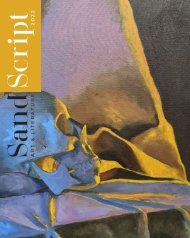SandScript 2023 [Digital Exclusive]
Create successful ePaper yourself
Turn your PDF publications into a flip-book with our unique Google optimized e-Paper software.
provides a natural way of learning language. D. Holdaway in The Foundations of Literacy<br />
puts it this way, “Chant, song, dance, and linguistic rituals are among the most powerful forms<br />
of human learnings” (57-58). Holdaway continues with describing music and movement as,<br />
“primitively satisfying, deeply memorable, and globally meaningful. Much of its power comes<br />
from the sense of security generated by repetition, familiarity, and universality” (57-58). These<br />
are the keys to learning any type of music or foreign language: repetition, familiarity, and<br />
universality. The children and students need to feel comfortable with what they are learning,<br />
and in order to accomplish this, the teacher needs to have ways of lowering the affective filter<br />
in the classroom. With the frequent use of music, this allows for children and students to add<br />
to their understanding of the rhythm of language in a joyful, natural way.<br />
When it comes to familiarity, students need to be encouraged to practice singing a new<br />
song they have just learned, until they know it well. Once the students know the words, they<br />
are comfortable with the rhythm of the song and are able to associate the words, especially if<br />
they are given recall exercises. One commonly used activity of this in any classroom is the fill in<br />
the blank activity. Students familiarize themselves with a song and eventually they are able to<br />
fill in the gaps of missing information. Because they learn the words to the rhythm and melody<br />
of a song, the students become more comfortable in learning to recognize the written words.<br />
The songs themselves give a structure and a pronunciation that will forever be burned in the<br />
mind of a learner. The end result shows that reading tends to come more naturally to students<br />
who learn to sing the words first (James 36).<br />
Music has become a great tool in teaching a foreign language, one that opens the minds<br />
of the students to be creative. One way of using music to teach that has become successful<br />
is what I have mentioned before with playing background music in the classroom. Along<br />
with generating a comfortable environment, the use of background music also stimulates<br />
the minds of the learners, allowing for creativity to flow. Carmen Fonseca Mora mentions<br />
an example of this stimulating exercise in her journal article “Foreign Language Acquisition<br />
and Melody Singing.” She explains that during this process an interaction of faculties build<br />
up our understanding of our environment. This had been previously confirmed during an<br />
experiment of Ray Jackendoff in 1992 in his book Languages of the Mind: Essays on Mental<br />
Representations:<br />
The participants were given a picture and asked to tell a story related to it that<br />
included a beginning, a climax, and an ending. They could choose whether to<br />
speak in Spanish or English. Before narrating the same story for a second time, they relaxed<br />
by listening for three minutes to quiet instrumental music that included water sounds and<br />
birdsong. They were then asked to repeat the same story they had told some moments ago.<br />
The background music was not switched off while they were speaking, although the volume<br />
was turned down. During the second narration they started verbalizing information that had<br />
not been coded visually, but rather proceeded from the musical input. They included things<br />
that were not in the original picture and, taking the position of an omniscient narrator, they<br />
talked about the characters’ feelings. In this way, visual, auditory-musical, and emotional<br />
information was encoded linguistically (147-148).<br />
201


![SandScript 2023 [Digital Exclusive]](https://img.yumpu.com/68282062/204/500x640/sandscript-2023-digital-exclusive.jpg)



